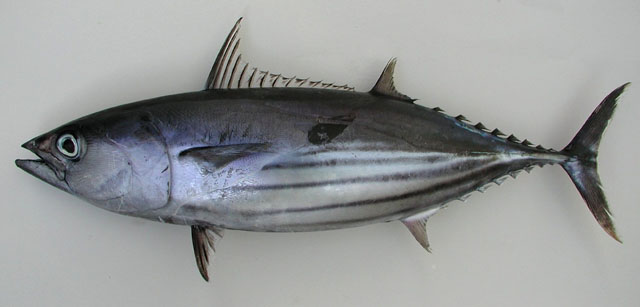| Scombridae (Mackerels, tunas, bonitos), subfamily: Scombrinae |
| 110 cm FL (male/unsexed); max.weight: 35 kg; max. reported age: 12 years |
|
pelagic-oceanic; marine; depth range 0 - 260 m, oceanodromous |
| Cosmopolitan in tropical and warm-temperate waters. Not found in the Black Sea. Highly migratory species, |
|
Dorsal spines (total): 14-16; Dorsal soft rays (total): 14-15; Anal spines: 0-0; Anal soft rays: 14-15; Vertebrae: 41-41. This species is distinguished by the following characters: body fusiform, elongate and rounded; teeth small and conical, in a single series; gill rakers on first gill arch numerous, 53-63; D1 XIV-XVI, dorsal fins separated by a small interspace (not larger than eye), the second followed by 7-9 finlets; anal fin followed by 7-8 finlets; pectoral fins short, with 26-27 rays; 2 flaps (interpelvic process) between pelvic fins; body scaleless except for corselet and lateral line; a strong keel on each side of caudal-fin base between 2 smaller keels. Colour of back dark purplish blue, lower sides and belly silvery, with 4-6 very conspicuous longitudinal dark bands which in live specimens may appear as discontinuous lines of dark blotches (Ref. 9684). |
| Found in offshore waters; larvae restricted to waters with surface temperatures of 15°C to 30°C (Ref. 6390). Exhibit a strong tendency to school in surface waters with birds, drifting objects, sharks, whales and may show a characteristic behavior like jumping, feeding, foaming, etc. Feed on fishes, crustaceans, cephalopods and mollusks; cannibalism is common. Spawn throughout the year in the tropics, eggs released in several portions (Ref. 35388). Eggs and larvae are pelagic (Ref. 6769). Preyed upon by large pelagic fishes (Ref. 6885). Also taken by trolling on light tackle using plugs, spoons, feathers, or strip bait (Ref. 9684). Marketed fresh, frozen or canned (Ref. 9340, 9684 ); also dried-salted and smoked (Ref. 9987). |
|
Least Concern (LC); Date assessed: 15 January 2021 Ref. (130435)
|
| reports of ciguatera poisoning |
|
They inhabit waters off the east coast from Lady Elliot Island in Queensland to Storm Bay in Tasmania, but are not present within the Great Barrier Reef. The southern limit of distribution on the east coast varies seasonally (Ref. 168), such that in late winter and spring the fish are not found south of the New South Wales-Victorian border. In the west, their distribution extends from Kangaroo Island in the Great Australian Bight to Cape Leeuwin in southern Western Australia, and north to Broome (Ref. 168).
Stock structure: The stock structure of skipjack tuna as of 1993, from the Pacific and Indian oceans has not been determined. Only 2 of the several hypotheses for Pacific Ocean skipjack tuna stock structure are widely supported. The first proposes at least 5 sub-populations within the Pacific, including 2 in the western Pacific (Ref. 28952); and the alternative hypothesis proposes that whereas there are no distinct subpopulations, the probability of skipjack tuna schools interbreeding is proportional to the distance between each group (Ref. 28959, 28961). There is no information on the stock structure of skipjack tuna in the Indian Ocean.
Commercial fishery: Skipjack tuna have been caught by Australian commercial fishers since the development of pole-and-line fisheries targeting southern bluefin tuna (Thunnus maccoyii) in the 1950s. However, only small amounts of skipjack tuna are targeted in this fishery in most years because of their lower value. Additionally, purse seine vessels operating in the southern bluefin tuna fishery have taken significant catches of skipjack tuna in some years, particularly in the Great Australian Bight. The total catch of skipjack tuna taken varied between 100 t and 1200 t per year between 1975-76 and 1989-90.
The main fishing area for skipjack tuna in Australia is in the southeast from Ulladulla to just south of Gabo Island. Two methods are used in the fishery: pole-and-line and purse seining. The fishery has developed from catches of about 150 t in 1985-86 to an estimated 6000 t in 1990-91 and 1991-92, and 4689 t in 1996-97. Purse seine vessels generally land a greater proportion of the catch. Pole-and-line vessels often fish skipjack tuna schools in co-operation with purse seine vessels. Yellowfin tuna (Thunnus albacares) and albacore (T. alalunga) are taken as bycatch of both fishing methods.
The fishing season normally extends from December to March. The skipjack tuna caught are usually between 2 kg and 3 kg, yet larger fish tend to be caught late in the season in southern waters.
The main pot of landing for skipjack tuna is Eden, and the cannery there processes most of the Australian catch. Some skipjack tuna is processed at the Port Lincoln cannery in South Australia. Some of the skipjack tuna catch is sold for bait depending on demand from other fisheries and the prevailing price for canning fish. Only a small amount is sold on the domestic fresh fish market.
Recreational fishery: Skipjack tuna are commonly caught by sport and recreational fishers in southeastern Australian waters. Most fish are caught by trolling or casting small lures from a boat. Catches are also made using flies or baits of whole, small fish or flesh strips (Ref. 27128). Skipjack tuna are often used as live or dead baits for larger tuna species and billfish. The flesh is also a popular bait amongst anglers for a variety of marine fish. The largest skipjack tuna caught under Game Fishing Association of Australia rules up to 1993, was 11.5 kg, landed in Queensland.
Resource status: There are no estimates of sustainable yield or stock size for skipjack tuna in Australian waters. An estimated 780,000 t of skipjack tuna were caught in the western Pacific (which includes Australia) in 1990 (Ref. 28956). Exploitation rates calculated from tagging studies indicate that significantly higher catches can be sustained (Ref. 28956, 28960, 28959). Also Ref. 2334. |
Source and more info: www.fishbase.org. For personal, classroom, and other internal use only. Not for publication.

